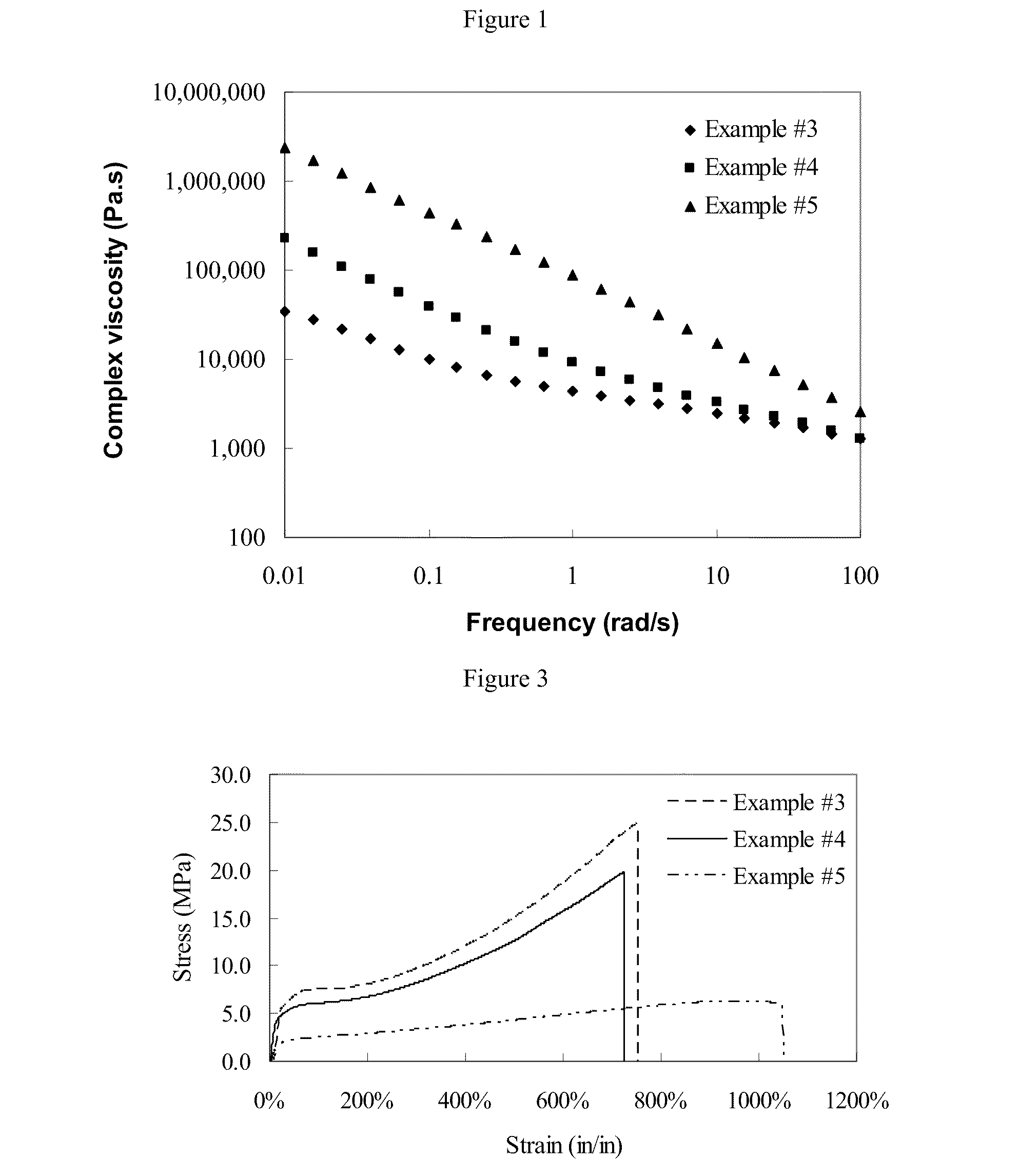Thermoplastic Polyolefin Blends
a technology of thermoplastic polyolefin and blend, which is applied in the field of thermoplastic polyolefin blend, can solve the problems of increasing modulus, reducing toughness, and insufficient miscibility of physical blends reducing toughness, and achieving the effect of reducing toughness
- Summary
- Abstract
- Description
- Claims
- Application Information
AI Technical Summary
Benefits of technology
Problems solved by technology
Method used
Image
Examples
examples 1 to 5
[0280]These examples demonstrate the use of a mixed catalyst polymerization in a single reactor operated in a continuous stirred-tank solution process. The catalysts employed were a biscyclopentadienyl zirconium dimethyl (Catalyst A) to produce higher density polyethylene and 1,1′-bis(4-triethylsilylphenyl)-methylene-(cyclopentadienyl)(2,7-ditert-butyl9-fluorenyl) hafnium dimethyl catalyst (Catalyst B) to produce lower density ethylene / hexene copolymer in the same reactor. The reactor was 1.0-liter stainless steel autoclave reactor equipped with a stirrer, a water-cooling / steam-heating element with a temperature controller, and a pressure controller. Solvents, monomers such as ethylene and hexene were first purified by passing through a three-column purification system. Purification columns were regenerated periodically whenever there was evidence of lower activity of polymerization.
[0281]Catalyst A was preactivated with N,N-dimethylanilinium tetrakis(heptafluoro-2-naphthyl)borate (...
examples 6 to 9
[0295]Examples 6 to 9 were made by following the same procedure used in Examples 1 to 5 except that different types of catalysts were used in Examples 7 and 8. In Example 7, 2,6-diacetylpyridine bis(2,4,6-trimethylphenylimine) iron dichloride (Catalyst C) was used to produce higher density polyethylene and Catalyst B was used for the lower density ethylene / hexene copolymer. 100 mg of 2,6-diacetylpyridine bis(2,4,6-trimethylphenylimine) iron dichloride was first mixed with 8 ml of tri-n-octyl aluminum solution (25 wt %) in 900 ml of toluene for at least 10 minutes, then 160 mg of Activator B was added into the solution to form a catalyst solution. In Example 8, pentamethyl cyclopentadienyl 1,3 dimethyl indenyl hafnium dimethyl (Catalyst D) was used to make higher density polyethylene and Catalyst B was used to produce the lower density ethylene / hexene copolymer. Pentamethyl cyclopentadienyl 1,3 dimethyl indenyl hafnium dimethyl was preactivated with Activator B at a molar ratio of ab...
example 10
[0299]The in-reactor blends produced in Examples 6 to 8 along with the comparative example of Example 9 and the commercial processability improver of LD-PE 200.48 were tested as a modifier (at a concentration of 10 wt %) for Exceed PE 2018E. The blends were prepared using a Brabender mixer (50-g capacity) at a mixing temperature of 200° C. The mixture of Exceed PE 2018 and the in-reactor blend was introduced in the preheated Brabender mixer together with 500 ppm of Irganox 1076 available from Ciba Specialty Chemicals Corporation, Tarrytown, N.Y., 1000 ppm of Irgafos 168 also available from Ciba Specialty Chemicals Corporation, Tarrytown, N.Y., and 800 ppm of Dynamar FX 5920A available from Dyneon LLC, Oakdale, Minn. A rotor speed of 50 rpm was used throughout the run and the system was kept at the temperature desired and stable. Mixing was continued for 10 min once all the blend components were incorporated in the Exceed PE 2018. Finally the blend was discharged from the mixer and a...
PUM
| Property | Measurement | Unit |
|---|---|---|
| Temperature | aaaaa | aaaaa |
| Temperature | aaaaa | aaaaa |
| Temperature | aaaaa | aaaaa |
Abstract
Description
Claims
Application Information
 Login to View More
Login to View More - R&D
- Intellectual Property
- Life Sciences
- Materials
- Tech Scout
- Unparalleled Data Quality
- Higher Quality Content
- 60% Fewer Hallucinations
Browse by: Latest US Patents, China's latest patents, Technical Efficacy Thesaurus, Application Domain, Technology Topic, Popular Technical Reports.
© 2025 PatSnap. All rights reserved.Legal|Privacy policy|Modern Slavery Act Transparency Statement|Sitemap|About US| Contact US: help@patsnap.com



